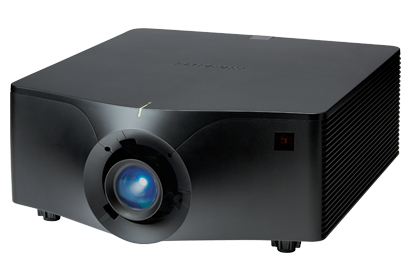United Kingdom
Museums & science centers
Christie DWU850-GS
The DWU850-GS at the Barbican Centre
As a world-class arts and learning centre, the Barbican in London and its technical team are faced with a stream of new installations and continual challenges - each one bringing very different content, artists, light conditions as well as locations. Walking in the truly vast building, there are huge, bright foyers which feature public displays of free digital art. The artists who create the work are generally present at projection trials. Projections have also included installations created by the young participants in the Barbican’s Creative Learning programmes. On the upper levels are dedicated exhibition spaces. The Centre owns several Christie laser projectors thanks to a long-term partnership with Christie, which include the DWU-850-GS lumens as well as the HS Series laser as well as flat screens and Christie Pandoras Box media server. So it is interesting to see just how the projector has proved itself in many situations, none more so perhaps than a recent exhibition in the Art Gallery on the third floor.
Technical manager Bruce Stracy had to project grainy, analogue film stock in a limited space. The projection was supporting the first major exhibition of dancer and choreographer Michael Clark, Michael Clark: Cosmic Dancer. The process hadn’t got off to a flying start.
Stracy takes up the story…
"We had a variety of projectors and tried non-Christie options – and they just didn’t work,” he explains. “Luckily enough the Music Department had a DWU850-GS and they had bought the whole set of lenses with the projector, and we borrowed the entire kit from them. So where we had a difficulty with throw distance from the screens we nailed it without too much manipulation, which was ideal for me."
"We are faced with different install situations so I have to balance the weight of the projector and where we can place it," said Stracy. "The Barbican is a listed building so I have to pick and choose. The projector is quite compact."
Noise levels were another factor. "One of the nice things about the GS is that it is very quiet as we have restricted ceiling space in the Gallery and it is close to the audience,” he said. “This is definitely one of its big benefits as sound levels is an issue I have to factor into any consideration."
Lens options, quality and Christie processing software also turned out to be critical issues. They were projecting a 3035mm x 2210mm image with a throw of 4400mm. The ceiling height was 3.2m (10.5 feet). Stracy chose a 0.95-1.22:1 Zoom Lens. Naturally the projector would throw a 16:9 image, the Michael Clark film was a 4:3 image. “When we use a lamp on a 4:3 ratio I have to use manual masking to minimise bleeding out; with laser there is no overspill on a 4:3 image and with the GS, because of RealBlack, you get clear black borders rather than perhaps a more greyish or blurred effect you might with other projectors. This is another plus side as it actually crops the image properly,” shared Stracy.
Great projector, great lens – the perfect marriage
"Unfortunately, the film stock wasn’t particularly good - old, analogue and transposed - so we pushed that as far as it would go but the projector handled it well keeping the image clear without further distortion. Not all projectors are equal." Stracy continues, "What contributes to the image is the amalgamation of the projector and a fantastic lens. The quality of one has to support the quality of the other."
As well as RealBlack, the 850-GS at 8,000 lumens also has Christie BoldColor Technology, which offers enhanced color performance and saturation over standard competing laser projection in the same class. Speaking more broadly to the wider use of the projector and its value at the Barbican, Stracy says, "The video processing, color fidelity and higher contrast contribute to giving a better or sharper image. In this case, it was how much feel you can get from a 2D image, creating a more intimate effect when an audience will be upfront and close with pixels and a big image. Definition was important. But for some of our content, color is a bigger issue," adding that, "Color fidelity can be useful for corporate or other sectors, where preserving brand color or logos is important."
Elsewhere in the Barbican, the DW850-GS has often been used alongside a rolling programme of commissioned digital artists. Some projections have been blended and interactive so visitors have been able to get involved and often up close. "To be honest the brightness and image quality is good, really good – the Gallery is a darker space but, in the foyer, there are two GS projectors blended side-by-side in an almost daylight situation," commented Stracy.
The relationship with Christie meant that the Barbican was a relatively early adopter of laser projection and Stracy predicts that the cost effectiveness of laser will be seen more, especially combined with other functionality. "Looking at laser long term for 20 000 hours, 7 days a week, ten hours a day, it’s not just lamp costs but savings on crew – then when you add in quality of image and contrast the money spent upfront starts to even off. So it will be about value for money."
"The GS is very adaptable, has a good choice of lenses, brightness and image, and is maintenance free. That’s what makes it such a good workhorse," concludes Stracy. "The projector really hits the spot, it can fulfil a range of customer expectations. The fact we had one I could borrow was brilliant."



